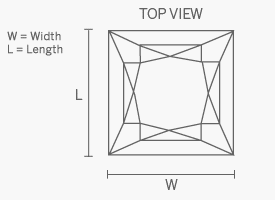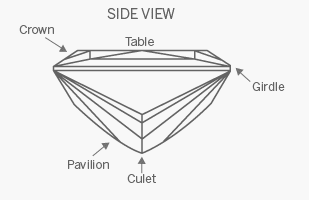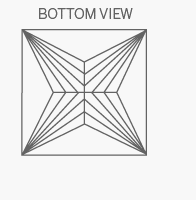Princess Cut Diamond Shape
The Essential 7C's
Every diamond has its own story, and every lady her own style.
At this point it should be noted that the shape of a diamond can also be referred to as its “cut”, like a round or princess cut. However, this should not be confused with the more commonly used term of diamond cut, which describes how well the diamond has been polished from the raw material (see section on diamond cut).
At Seventy Seven Diamonds we cater to the detailed wishes of every customer and want to ensure that they are well-informed about every diamond shape available. Our selection of beautiful shapes is accompanied by detailed information, images and recommendations on the uniqueness, the history and background, and the ideal ratio of every cut.
Princess Cut Diamonds
1. The Basics | 2. Features | 3. Expert Advice | 4. History
1. The Basics
Also referred to as: SQUARE - OR RECTANGULAR MODIFIED BRILLIANT

| Unique Features |
Facets |
L/W Ratio |
Origin |
Expert Tip |
| Contemporary square cut, most brilliant of all square shapes. |
Usually 57 or 76 |
1.00-1.05 (square) > 1.05 (rectangular) |
1970's, developed from barion & quadrillion cuts. |
Ideal for long fingers and eternity bands. |
2. Features



The Princess cut is the square version of the brilliant round cut usually comprised of either 57 or 76 facets with a typical ratio of 1.0 to 1.05.
Its pyramidal shape with four bevelled sides creates more light dispersion than any other square shaped diamond, making it popular for both solitaire engagement rings and earrings.
As it is a patented cut, it may be referred to as a Square Modified Brilliant on a laboratory certificate (eg. GIA or AGS), or a Rectangular Modified Brilliant if it has a ratio greater than 1.05.
3. Expert Advice
“Because of its extra facets, the Princess cut can disperse more light through the stone, this serves to hide inclusions more efficiently, making it the most brilliant of all square- and rectangular-shaped stones. It is also a popular cut for wedding bands because the stones can be arranged side by side without any gaps, making it ideal for an eternity band too. Furthermore, due to its sharply squared corners, the Princess is an ideal cut for long fingers.”
4. History & Background
The name "Princess Cut" was originally used in connection with another diamond cut known as the "Profile" cut, which was designed by London cutter Arpad Nagy in 1961. The same name was later used and made popular by Ygal Perlman, Betzalel Ambar, and Israel Itzkowitz in Israel, who in 1979 created the Princess cut (or Square Modified Brilliant) as it is known today.
Other precursors of the Princess cut include the Barion – a square cut with rounded corners created in 1971 by South African cutter Basil Watermeyer, and the Quadrillion – a similar cut with only 49 facets, also created by Perlman, Ambar and Itzkowitz and initially distributed by Ambar Diamonds in Los Angeles. Following several years of optical research, the modern Princess cut was created – a square stone of 58 facets arranged similarly to those of a round brilliant cut diamond.

Where next?
To view princess cut diamonds offered by Seventy Seven Diamonds, please click here.
To customise your princess cut engagement ring, please click here.
If you would like to read more about diamond education, please click here.